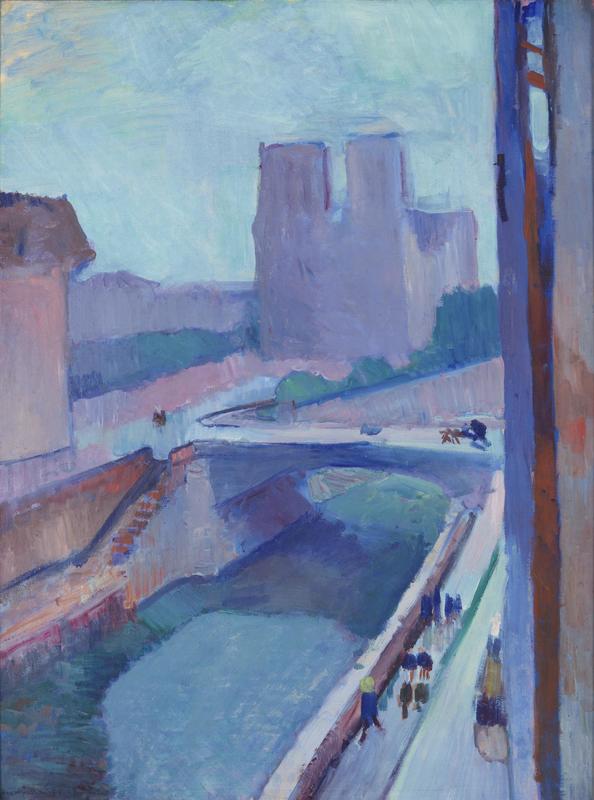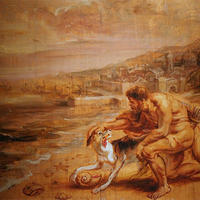More about A Glimpse of Notre Dame in the Late Afternoon

Sr. Contributor
Henri Matisse painted views of Notre Dame all his life, and never the same way twice.
This painting comes from his 'Dark Period' during which his life was rocked by a scandal that would forever skew his reputation. Similar to van Gogh, Matisse wasn’t always appreciated in his time. Matisse gave a portrait of his daughter to one of his contemporaries, Picasso, who made a game with his buddies of tossing darts at it. He was known as an un-hip, older artist because most people simply couldn’t wrap their heads around his unique style of painting. Picasso’s gang even went around vandalizing posters warning about the toxicity of lead paint by writing “Painters stay away from Matisse!” on them.
This painting was done in 1902, the same year that Matisse’s parents-in-law got caught in a financial scandal. It was well-publicized at the time, but became a buried secret until 1998 when a biographer published an account of it. The parents-in-law had both been working for the Humbert family, whose company was revealed to be a giant scam which affected many in the upper echelon of French society - politicians, bankers, etc. Ten thousand people showed up at the Humbert mansion in an angry mob when the news broke, but the couple had already disappeared.
Matisse’s parents-in-law hadn’t known about the illegal inner workings of the company, but they were the only ones around for the enraged public to point the finger at. Things around Matisse unraveled real quickly; his father-in-law was imprisoned and his own studio was searched for evidence. With a background in law, Matisse found himself right in the center of the scandal, as he prepared the defense for his father-in-law’s trial.
After successfully getting his father-in-law acquitted of all charges, Matisse's reputation was still on a downward spiral, and he was deemed “that idiot Matisse” by those who only vaguely knew him. His wife lost both the hat shop she was running to support Matisse while he built his career as a painter, and her apartment. Matisse’s father also suffered unrelated financial losses around the same time. After suffering so much humiliation in the public eye, no wonder he took on a “boring" affect to appear respectable.
All this to say, Matisse had several personal reasons that influenced his 'Dark Period', reflected in the the darker tones used in this painting, as compared to the brighter, vibrant shades of his later, more famous pieces, such as Open Window, Collioure. Matisse had a lifelong love for Notre Dame but every painting is distinctly different as his style changed and evolved. Notre Dame done two years early is Impressionistic, while this one shows hints of Fauvism, a new movement he helped develop. The commonality in them is the influence Cézanne.
His wife, Amelie, ever his ardent supporter, sold an emerald ring she treasured so that Matisse could purchase Cézanne’s Three Bathers. The artist began each day by admiring it, as his biographer writes: “by the first rays of sun shining behind Notre Dame.”
In 1914, Matisse painted two pieces called View From Notre Dame. The second of which he held back on exhibiting for 35 years, worried that people wouldn’t 'get it.' They didn’t. But when he’d first finished them, a friend wrote to him saying he preferred the painting he knew people wouldn’t understand.
Sources
- “Henri Matisse. View of Notre Dame. Paris, Quai Saint-Michel, Spring 1914: Moma.” The Museum of Modern Art. Accessed March 17, 2022. https://www.moma.org/ collection/works/78863.
- Luke, Ben. “Henri Matisse's ‘Notre Dame.’” Art UK. Arts Council England, June 29, 2020. https://artuk.org/discover/stories/henri-matisses-notre-dame.
- “Notre-Dame, Une Fin D'apres-Midi.” Matisse Paintings. Accessed March 17, 2022. https://www.matissepaintings.org/notre-dame-une-fin-d-apres-midi/.
- “Notre-Dame, Une Fin D'après-MIDI (a Glimpse of Notre Dame in the Late Afternoon): Albright-Knox.” Albright-Knox. Accessed March 17, 2022. https://www.albrightknox. org/artworks/192724-notre-dame-une-fin-dapr%C3%A8s-midi-glimpse-notre-dame-late-afternoon.
- Russell, John. “Matisse Father & Son: A Checkered Childhood 1900-1920.” The New York Times. The New York Times. Accessed March 17, 2022. https://archive.nytimes.com/ www.nytimes.com/books/first/r/russell-matisse.html.
- Smee, Sebastian. “Perspective | How Notre Dame Inspired Henri Matisse, Who Depicted the Cathedral as a Living Memory.” The Washington Post. WP Company, April 16, 2019. https://www.washingtonpost.com/entertainment/museums/how-notre-dame-ins…- henri-matisse-who-depicted-the-cathedral-as-a-living-memory/2019/04/15/ef5bc59e-5fbf-11e9-9ff2-abc984dc9eec_story.html.
- Spurling, Hilary. “Cultural Comment: Essay: The Scandalous Triple Failure of Henri.” The Independent. Independent Digital News and Media, November 1, 1998. https://www.independent.co.uk/arts-entertainment/cultural-comment-essay…- scandalous-triple-failure-of-henri-matisse-1182066.html.
Featured Content
Here is what Wikipedia says about Notre-Dame, une fin d'après-midi
Notre-Dame, une fin d'après-midi ("A Glimpse of Notre-Dame in the Late Afternoon") is a painting by Henri Matisse from 1902. Its somber coloration is typical of Matisse's works executed between the end of 1901 and the end of 1903, a period of personal difficulties for the artist. This episode has been called Matisse's Dark Period.
The work is an oil painting on paper mounted on canvas and it measures
72.5 by 54.5 centimetres (28+1⁄2 by 21+1⁄2 inches). It is in the Albright–Knox Art Gallery, Buffalo, New York.
Check out the full Wikipedia article about Notre-Dame, une fin d'après-midi













